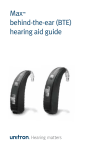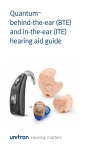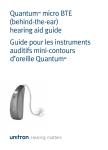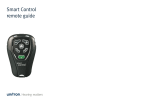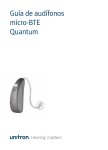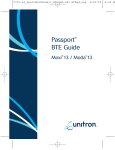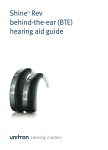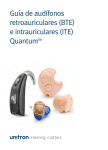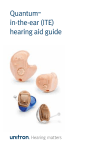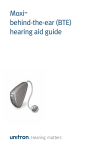Download Unitron Quantum micro BTE Operating instructions
Transcript
Quantum micro BTE (behind-the-ear) hearing aid guide Thank you Thank you for choosing Unitron hearing aids. At Unitron, we care deeply about people with hearing loss. We work closely with hearing healthcare professionals to make advanced, purpose-driven solutions available to everyone. Because hearing matters. Your hearing aids Hearing healthcare professional:______________ ____________________________________ Telephone:_ __________________________________ Model:_______________________________________ Serial number:_ _______________________________ Replacement batteries: Size 312 Warranty:_ ___________________________________ Program 1 is for: _______________________________ Program 2 is for: _ _____________________________ Program 3 is for: _ _____________________________ Program 4 is for: _ _____________________________ Date of purchase:______________________________ Quick reference Changing batteries Low battery warning 2 beeps every 30 minutes Plus (+) signs 312 On/Off on off open Push button switching programs volume control; right aid=louder, left aid=softer comfort-clarity control; right aid=clarity, left aid=comfort Table of contents Your hearing aids at a glance............................................................2 Putting your hearing aids on your ears.............................................4 Turning your hearing aids on and off .............................................. 6 Battery information.......................................................................... 8 Tips for wearing hearing aids for the first time...............................12 Operating instructions....................................................................14 Using the telephone...................................................................... 20 Caring for your hearing aids............................................................21 Cleaning your hearing aids............................................................ 22 Signature features of your hearing aids........................................ 26 Troubleshooting guide................................................................... 29 Warnings........................................................................................ 34 Warning to hearing aid dispensers (to comply with the U.S. Food and Drug Administration (FDA) regulations) ................................................ 38 Compliance information.................................................................41 Client feedback.............................................................................. 43 Additional notes............................................................................. 44 Your hearing aids at a glance 1 E arhook - your custom made earmold attaches to your hearing aids using the earhook 2 Microphone - sound enters your hearing aids via the microphones. Microphone shield - protects microphones from dirt & debris 3 Push button - switches between listening programs or changes the volume level or comfortclarity, depending on your customized fitting 4 Battery door/on & off - close the door to turn on your hearing aids, partly open the door to turn off your hearing aids. Opening the door all the way gives you access to change the battery 5 Earmold - allows the sound to pass from the hearing aids to the ear and holds the hearing aids in place 6 Slim tube - sound travels down the slim tube to the ear canal 7 Dome - holds the slim tube in place in your ear canal 8 Retention piece - helps prevent the dome and slim tube from moving out of the ear canal 2 2 3 2 1 4 5 2 3 2 6 4 8 7 3 Putting your hearing aids on your ears Your behind-the-ear (BTE) hearing aids may be color-coded with a small dot on the battery door: red = right ear; blue = left ear. BTEs with earmolds 1.Hold the earmold between 1. your thumb and index finger. The opening should be pointing in towards your ear canal with the BTE resting upwards over the top of your ear. 2.Carefully insert the earmold 2. in your ear. You may need to twist it slightly to the back. The earmold should fit into your ear snugly and comfortably. Pulling down and back on your earlobe may help you insert the earmold into your ear canal more easily. 4 3.Place the hearing aid over the top of your ear. 3. BTEs with slim tubes 1.Place the hearing aid over the top of your ear. The slim tube should lie flush against your head and not stick out. 1. 2.Hold the slim tube where it attaches to the dome and gently push the dome into your ear canal. 2. 3.Place the retention piece in your ear so it rests at the bottom of the opening of your ear canal. 3. 5 Turning your hearing aids on and off Your hearing aids have a three-position battery door that acts as an on/off switch and that allows access to the battery compartment. 1.ON: Close the battery door fully. Note: It may take 5 seconds before the hearing aid turns on. Your hearing healthcare provider can additionally increase the start up delay if required. 2.OFF: Partially open the battery door. 1. on 2. off 6 3.OPEN: Fully open the battery door to access and change the battery. 3. open Note: When turning your hearing aid on and off while it is on the ear, grasp the top and bottom of the device with your index finger and thumb. Use your thumb to open and close the battery door. 7 Battery information To replace the battery, fully open the battery door for access to the battery compartment. Low battery warning Two long beeps indicate the hearing aid battery is low. After the low battery warning, you may experience some reduction in sound quality. This is normal and can be remedied by inserting fresh batteries into the hearing aids. If you are not able to hear the low battery warning, your hearing healthcare professional can change the pitch or loudness of the low battery warning. If you prefer, it can be turned off entirely. 8 our hearing aids are designed to generate a Y low battery warning every 30 minutes until you change the batteries, but depending on the condition of the batteries, they may die before another low battery warning occurs. Therefore, it is recommended that the batteries are replaced as soon as possible once you hear the low battery warning. Replacing the battery 1. 1.Gently swing out the battery door with your fingernail. 2.Grasp the battery with your thumb and index finger and remove. 2. 3.Insert the new battery into the 3. battery compartment with the plus (+) sign on the battery facing the same way as the plus (+) sign on the side of the battery door. This will ensure that the battery door closes properly. Note: If the battery is inserted incorrectly, the hearing aid will not turn on. 4. Close the battery door. 4. 9 Replacing the battery in hearing aids with a tamper-resistant battery door Some hearing aids have a tamperresistant battery door for safety reasons. To replace the battery, open the battery compartment and push the locking piece back inside the hearing aid using the tip of a pen. Remove the old battery. Insert a new one with the plus (+) sign on the battery facing the same way as the plus (+) sign on the side of the battery door. The new battery will be secured when you close the battery door. 10 1. 2. 3. Caring for batteries Always discard batteries in a safe and environmentally friendly way. To prolong battery life, remember to turn your hearing aids off when not in use. Remove the batteries and keep the battery door open while hearing aids are not in use. This will allow internal moisture to evaporate. 11 Tips for wearing hearing aids for the first time 1.Start in a quiet room at home first to get used to the new sound quality. Sounds like the ticking of a clock, the humming of the computer, the beep of the microwave or the rustling of clothes or paper may seem loud to you at first, because you have not been hearing them properly for a long time. 2.Read aloud to yourself and learn to correct the volume of your own voice when you are wearing the hearing aids. 3.Talk to different people and learn how to distinguish between different sound patterns again. 4.It will take some time before you are completely used to your hearing aids and can fully enjoy the benefits. 5.Wear your hearing aids for as many hours a day as you can, and for a little longer each day. 12 6. Make notes at the back of this booklet, write down difficult situations and describe what any unpleasant noises were like. This information will help your hearing healthcare professional to fine-tune the devices better for you. 7.Involve your family and friends in this familiarization period. For example, ask someone to set the television to a comfortable volume. 8.When you are beginning to get used to wearing the hearing aids, wear them in more difficult listening environments such as the office, at parties or in restaurants. This can be difficult even for people who can hear normally. Give yourself time to regain your ability to hear in these difficult situations. 9.Make your hearing aids part of your everyday life and be patient with yourself until you have retrained yourself to interpret the sounds correctly. 13 Operating instructions Your BTE hearing aids come with a push button that allows you to further adjust your hearing aids. Push button Your hearing aids are equipped with a push button which can be set for switching between programs, to adjust your volume or adjust the comfort-clarity control. Program control If the push button has been configured as a program control, each time you push the button, you will move to a new hearing aid program. Your hearing aids beep to indicate which program you are in. 14 Program 1 (e.g. automatic program) Program 2 (e.g. speech in noise) 1 beep Program 3 (e.g. telephone) 3 beeps 2 beeps 4 beeps Program 4 (e.g. music) DuoLink (if enabled) (see pg 20) Opposite ear beeps the same as side being adjusted Volume control If the push button has been configured as a volume control: • Push the button on your right hearing aid to increase the volume in both hearing aids. • Push the button on your left hearing aid to decrease the volume in both hearing aids. Volume setting Recommended volume level Beeps 1 beep Turning volume up short beep Turning volume down short beep Maximum volume level 2 beeps Minimum volume level 2 beeps 15 Comfort-clarity control If the push button has been configured as a comfort-clarity control: • Push the button on your right hearing aid to increase clarity of speech. • Push the button on your left hearing aid to decrease overall noise or improve listening comfort. Each step will change the hearing aid performance. Sometimes multiple steps are required to achieve the desired listening results. After each press wait for about 4-5 seconds to allow the hearing aid to adjust to the new setting. As you change the comfort-clarity level, your hearing aids will beep. 16 Comfort-clarity control setting Ideal comfort and clarity level Increase sound clarity level Beeps 1 beep short beep Increase listening comfort short beep Maximum sound clarity level 2 beeps Maximum listening comfort level 2 beeps 17 DuoLink If DuoLink is enabled, then changing the volume, program or comfort-clarity setting on one hearing aid, will automatically make the change to both hearing aids at the same time. For example, if your push button is configured as a program control and DuoLink is enabled, when you push the button on your right hearing aid, the program will change in both hearing aids. Learning Your hearing aids will learn your adjustments in different environments, if this feature is available and has been enabled by your hearing healthcare professional. Over time, the hearing aids will adjust the default volume and comfortclarity settings to the levels that you typically use. 18 Remote control Your hearing aids may also come with an optional remote control which allows you to switch between different listening programs, and change your volume or comfort-clarity settings. 19 Using the telephone As telephones do not all work the same, you may experience different results from different phones. You can use many phones by simply holding the receiver to your ear, without the need to change to a dedicated telephone program on your hearing aids. Remember to move the handset slightly up or back to find the position that sounds best to you. Depending on the phone type you use, your hearing healthcare professional might have selected a dedicated phone program on your hearing aids. If your hearing aids are configured to work with the wireless uDirect neck worn accessory, you might benefit from a Bluetooth hands free option. Refer to the uDirect user guide for more information. ™ ® ® Bluetooth is a registered trademark of Bluetooth SIG Inc. 20 Caring for your hearing aids Open the battery door when not in use. Always remove your hearing aids when using hair care products. The hearing aids can become clogged and cease to function properly. Do not wear your hearing aids in the bath or shower or immerse them in water. If your hearing aids do become wet, do not attempt to dry them in an oven or microwave. Do not adjust any controls. Open the battery doors immediately, and allow your hearing aids to dry naturally for 24 hours. Protect your hearing aids from excessive heat (hair dryer, vehicle glove box or dashboard). Regular use of a dehumidifier, such as a Dri-Aid kit, can help prevent corrosion and prolong the life of your hearing aids. Do not drop your hearing aids or knock them against hard surfaces. 21 Cleaning your hearing aids Ear wax is natural and common. Ensuring your hearing aids are free of ear wax is an important step in your daily cleaning and maintenance routine. Never use alcohol to clean your hearing aids, earmolds or domes. Do not use sharp tools to dislodge ear wax. Sticking household items into your hearing aids or earmolds can seriously damage them. Earmolds Always ensure earmolds are clean and free of earwax. Do not use alcohol to clean your earmolds. If the earmolds become plugged, clear the opening with a wax loop or pipe cleaner. If your physician prescribes eardrops, clean any moisture that may get into the earmolds or tubing to prevent plugging. 22 If the earmolds require further cleaning: 1.Disconnect the plastic tube from the hook of the hearing aids. 2.Wash only the earmolds in warm water with a mild soap. 3.Rinse them with cool water and dry overnight. 4.Make sure the earmold tubes are dry before reconnecting them to each hook on your hearing aids. Use of a hearing aid blower can assist with removing moisture/debris from tube. See your hearing healthcare professional for more information. 23 Slim tubes and domes You should have the slim tubes and domes replaced by your hearing healthcare professional approximately every three to six months or when they become stiff, brittle, or discolored. Clean the domes daily with a damp cloth. You should also clean the slim tubes periodically, with the cleaning pin provided, when you begin to notice debris in and around the tubes. 1. Hold the slim tube in one hand and the hearing aid in the other hand. 2. Gently turn the hearing aid until it detaches from the slim tube. 3. Use a damp cloth to clean the outside of the slim tube and dome. 4. Remove the dome from the slim tube by pulling gently, before cleaning the slim tube. 24 5. Using the black cleaning pin provided in the kit, gently insert the cleaning pin where the slim tube attaches to the hearing aid and push the pin all the way through the tube. Note: The slim tubes and domes should never be rinsed or submerged in water as water drops may become lodged in the tube, block sound or damage the electrical components of the hearing aid. 6. Once the slim tube has been cleaned, reattach it by gently turning the hearing aid onto the slim tube. 7.Reattach the dome to the slim tube by gently pushing it back onto the threading at the end of the tube. 25 Signature features of your hearing aids Comfort-clarity control Your hearing aids automatically adjust to focus on hearing speech more clearly or providing comfort in noisy situations. Some Quantum BTE hearing aid models provide a control to adjust your comfort-clarity settings. • Adjusting the comfort-clarity control up causes your hearing aids to focus more on speech clarity. • Adjusting the comfort-clarity control down causes your hearing aids to soften background noise, providing more comfort. Comfort-clarity control adjustments can be made using the controls on your hearing aids or a remote control. Please talk with your hearing healthcare professional to find out which controls have been programmed for the comfort-clarity control. 26 As you adjust the comfort-clarity control, your hearing aids will gradually learn your preferred comfort-clarity settings. DuoLink With DuoLink, your hearing aids wirelessly communicate with each other. As you make a program, comfort-clarity or volume change on one hearing aid, the other hearing aid automatically changes as well. Binaural Phone The Binaural Phone feature enables you to hold a landline or mobile phone to one ear and hear the sound clearly in both ears. No accessories are required. 27 uDirect and uTV The uDirect and uTV are optional accessories for all Quantum micro BTE hearing aids. ™ ™ •u Direct provides easy, hands-free access to Bluetooth enabled devices, such as mobile phones. It also has a wired audio jack to plug in devices like MP3 players. •u TV is used with the uDirect to transmit sound from your TV directly to your hearing aids. The uTV can also transmit sound from stereo systems, computers and other audio sources. For more information on using the uDirect or uTV, please see the user guide for that accessory. For information on how to get a uDirect or uTV accessory, please contact your hearing healthcare professional. 28 Troubleshooting guide Cause Possible remedy No sound Not turned on Turn on Low/dead battery Replace battery Poor battery contact Consult your hearing healthcare professional Battery upside down Insert battery plus (+) side up Earmolds/slim tubes/ domes blocked with ear wax Clean earmolds/ domes. See “Cleaning your hearing aids”. Use cleaning pin to dislodge ear wax in slim tubes. Consult your hearing healthcare professional. Plugged microphone shield Consult your hearing healthcare professional 29 Cause Possible remedy Not loud enough Low volume Turn up volume; see hearing healthcare professional for models without a manual volume control or if problem persists. Low battery Replace battery Earmolds/slim tubes/ domes not inserted properly See “Putting your hearing aids on your ears”. Reinsert carefully. Change in hearing Consult your hearing healthcare professional Earmolds/slim tubes/ domes blocked with ear wax Clean earmolds. See “Cleaning your hearing aids”. Use cleaning pin to dislodge ear wax in slim tubes. Consult your hearing healthcare professional. Plugged microphone shield Consult your hearing healthcare professional 30 Cause Possible remedy Intermittent Low battery Replace battery Dirty battery contact Consult your hearing healthcare professional Two long beeps Low battery Replace battery Whistling Earmolds/slim tubes/ domes not inserted properly See “Putting your hearing aids on your ears”. Reinsert carefully. Hand/clothing near ear Move hand/clothing away from your ear Poorly fitting earmolds/slim tubes/ domes Consult your hearing healthcare professional 31 Cause Possible remedy Not clear, distorted Poorly fitting earmolds/ slim tubes/domes Earmolds/slim tubes/ domes blocked with ear wax Consult your hearing healthcare professional Clean earmolds. See “Cleaning your hearing aids”. Use cleaning pin to dislodge ear wax in slim tubes. Consult your hearing healthcare professional. Low battery Replace battery Plugged microphone shield Consult your hearing healthcare professional Earmolds/slim tubes/domes falling out of ear Poorly fitting earmolds/ slim tubes/domes Consult your hearing healthcare professional Earmolds/slim tubes/ domes not inserted properly See “Putting your hearing aids on your ears”. Reinsert carefully. 32 Cause Possible remedy Weak on the telephone Telephone not positioned properly Move telephone receiver around ear for clearer signal. See “Using the telephone”. Hearing aid requires adjustment Consult your hearing healthcare professional For any problems not listed in the guide, contact your hearing healthcare professional. If you do not have a hearing healthcare professional, please contact the nearest office listed on the back page of this booklet. 33 Warnings Hearing aids should only be used as directed by your physician or hearing healthcare professional. Hearing aids will not restore normal hearing and will not prevent or improve a hearing impairment resulting from organic conditions. Do not use your hearing aids in explosion hazard areas. Allergic reactions to hearing aids are unlikely. However, if you experience itching, redness, soreness, inflammation or a burning sensation in or around your ears, inform your hearing healthcare professional and contact your physician. In the unlikely case that any parts remain in the ear canal after the removal of the hearing aid, contact a physician immediately. 34 Remove your hearing aids for CT and MRI scans or for other electromagnetic procedures. Special care should be exercised in wearing hearing aids when maximum sound pressure levels exceed 132 decibels. There may be a risk of impairing your remaining hearing. Speak with your hearing healthcare professional to ensure the maximum output of your hearing aids is suitable for your particular hearing loss. Battery warnings Never leave hearing aids or batteries where small children and pets can reach them. Never put hearing aids or batteries in your mouth. If a hearing aid or battery is swallowed, call a physician immediately. 35 Precautions The use of hearing aids is only part of hearing rehabilitation; auditory training and lip reading instruction may be required as well. In most cases, infrequent use of hearing aids does not provide full benefit. Once you have become accustomed to your hearing aids, wear your hearing aids everyday all day. Your hearing aids use the most modern components to provide the best possible sound quality in every listening situation. However, communication devices such as digital cell phones can create interference (a buzzing sound) in hearing aids. If you experience interference from a cell phone being used close by, you can minimize this interference in a number of ways. Switch your hearing aids to another program, turn your head in a different direction or locate the cell phone and move away from it. 36 Note to hearing healthcare professional Domes should never be fitted on patients with perforated eardrums, exposed middle ear cavities, or surgically altered ear canals. In the case of such a condition, we recommend to use a customized ear mold. Labeling The serial number and year of manufacture are located inside the battery door. 37 Warning to hearing aid dispensers (to comply with the U.S. Food and Drug Administration (FDA) regulations) A hearing aid dispenser should advise a prospective hearing aid user to consult promptly with a licensed physician (preferably an ear specialist) before dispensing a hearing aid if the hearing aid dispenser determines through inquiry, actual observation, or review of any other available information concerning the prospective user, that the prospective user has any of the following conditions: (i) Visible congenital or traumatic deformity of the ear. (ii) History of active drainage from the ear within the previous 90 days. (iii) History of sudden or rapidly progressive hearing loss within the previous 90 days. (iv) Acute or chronic dizziness. (v) Unilateral hearing loss of sudden or recent onset within the previous 90 days. (vi) Audiometric air-bone gap equal to or greater than 15 decibels at 500 hertz (Hz), 1,000 Hz, and 2,000 Hz. (vii) Visible evidence of significant cerumen accumulation or a foreign body in the ear canal. (viii) Pain or discomfort in the ear. Special care should be exercised in selecting and fitting a hearing aid whose maximum sound pressure level exceeds 132 decibels because there may be risk of impairing the remaining hearing of the hearing aid user. [This provision is required only for those hearing aids with a maximum sound pressure capability greater than 132 decibels (dB).] Important notice for prospective hearing aid users Good health practice requires that a person with a hearing loss have a medical evaluation by a licensed physician (preferably a physician who specializes in diseases of the ear) before purchasing a hearing aid. 38 Licensed physicians who specialize in diseases of the ear are often referred to as otolaryngologists, otologists or otorhinolaryngologists. The purpose of medical evaluation is to assure that all medically treatable conditions that may affect hearing are identified and treated before the hearing aid is purchased. Following the medical evaluation, the physician will give you a written statement that states that your hearing loss has been medically evaluated and that you may be considered a candidate for a hearing aid. The physician will refer you to an audiologist or a hearing aid dispenser, as appropriate, for a hearing aid evaluation. The audiologist or hearing aid dispenser will conduct a hearing aid evaluation to assess your ability to hear with and without a hearing aid. The hearing aid evaluation will enable the audiologist or dispenser to select and fit a hearing aid to your individual needs. If you have reservations about your ability to adapt to amplification, you should inquire about the availability of a trial-rental or purchase-option program. Many hearing aid dispensers now offer programs that permit you to wear a hearing aid for a period of time for a nominal fee after which you may decide if you want to purchase the hearing aid. Federal law restricts the sale of hearing aids to those individuals who have obtained a medical evaluation from a licensed physician. Federal law permits a fully informed adult to sign a waiver statement declining the medical evaluation for religious or personal beliefs that preclude consultation with a physician. The exercise of such a waiver is not in your best health interest and its use is strongly discouraged. Children with hearing loss In addition to seeing a physician for a medical evaluation, a child with a hearing loss should be directed to an audiologist 39 for evaluation and rehabilitation since hearing loss may cause problems in language development and the educational and social growth of a child. An audiologist who is qualified by training and experience to assist in the evaluation and rehabilitation of a child with hearing loss is recommended. Cell phone Some hearing aid users have reported a buzzing sound in their hearing aids when they are using cell phones. According to the ANSI C63.19 standard, the compatibility of a particular hearing aid and cell phone can be predicted by adding the rating for the hearing aid immunity to the rating for the cell phone emissions. The sum of the hearing aid rating (e.g. M2/T2 = 2) and the telephone rating (e.g. M3/ T3 = 3) is 5, and any combination that equals 5 will provide ‘normal use’. A sum of 6 or greater indicates ‘excellent performance’. The equipment performance, measurements, categories and system classifications are based upon the best information available but cannot guarantee that all users will be satisfied. The rating of this hearing aid is at least M2/T2. Your hearing healthcare professional can provide the actual rating for this hearing aid. Note: the performance of the individual hearing aids may vary with individual cell phones. Therefore, please try the hearing aid with your cell phone or, if you are purchasing a new phone, please be sure to try it with your hearing aid prior to purchase. For additional guidance, please ask your hearing healthcare professional for the booklet entitled “Hearing aid compatibility with digital wireless cell phones”. 40 Compliance information Declaration of conformity Hereby Unitron declares that this Unitron product meets the requirements of the Medical Devices Directive 93/42/EEC as well as the Radio and Telecommunications Terminal Equipment Directive 1999/5/EC. The full text of the Declaration of Conformity can be obtained from the manufacturer. The hearing aid described in this user guide is certified under: Standard hearing system USA Canada FCC ID: VMY-UWBTE1 IC: 2756A-UWBTE1 Notice 1 This device complies with Part 15 of the FCC Rules and with RSS210 of Industry Canada. Operation is subject to the following two conditions: 1) this device may not cause harmful interference, and 2) this device must accept any interference received, including interference that may cause undesired operation. Notice 2 Changes or modifications made to this device not expressly approved by Unitron may void the FCC authorization to operate this device. 41 Notice 3 This device has been tested and found to comply with the limits for a Class B digital device, pursuant to Part 15 of the FCC Rules and ICES-003 of Industry Canada. These limits are designed to provide reasonable protection against harmful interference in a residential installation. This device generates, uses and can radiate radio frequency energy and, if not installed and used in accordance with the instructions, may cause harmful interference to radio communications. However, there is no guarantee that interference will not occur in a particular installation. If this device does cause harmful interference to radio or television reception, which can be determined by turning the equipment off and on, the user is encouraged to try to correct the interference by one or more of the following measures: • Reorient or relocate the receiving antenna • Increase the separation between the equipment and receiver • Connect the device into an outlet on a circuit different from that to which the receiver is connected • Consult the dealer or an experienced radio/TV technician for help 42 Client feedback Record your specific needs or concerns and bring to your first office visit after getting your hearing aids. This will help your hearing healthcare professional to address your needs. __________________________________________ __________________________________________ __________________________________________ __________________________________________ __________________________________________ __________________________________________ __________________________________________ __________________________________________ __________________________________________ __________________________________________ 43 Additional notes ____________________________________________ ____________________________________________ ____________________________________________ ____________________________________________ ____________________________________________ ____________________________________________ ____________________________________________ ____________________________________________ 44 Unitron distributors Corporate Office/International 20 Beasley Drive, P.O. Box 9017, Kitchener, ON N2G 4X1 Canada Australia Level 2, Norwest Quay, 21 Solent Circuit, Baulkham Hills, NSW, NSW 2153 Germany & European Representative Max-Eyth-Straße 20 70736 FellbachOeffingen, Germany Belgium Baron de Vironlaan, 60 b-1700 Dilbeek France 5 bis, rue Maryse Bastié - BP 15 69671 Bron Cedex Canada India 20 Beasley Drive, P.O. Box 9017, Kitchener, B-308, Everest Grande, Mahakali Caves Road, ON N2G 4X1 Andheri East, China Mumbai-400 093 No. 78, Qi Ming Road, Netherlands Export Processing Zone District B, Suzhou Ir. D.S. Tuijnmanweg 10, 4131 PN Industrial Park, P.R. VIANEN 215021 Colombia Ave. 15 No. 124 -29 Of 703 Bogotá, Colombia Denmark Østre Hougvej 42-44 5500 Middelfart New Zealand 10/215 Rosedale Rd., M277 Private Bag, 300987, Albany, Auckland South Africa First Floor – Selborne House, Fourways Golf Park, Roos Street, Fourways, Johannesburg Spain Avenida de la Industria nº13/15, Polígono de Canastell, 03690 Sant Vicent del Raspeig. Alicante, España Sweden Förmansvägen 2, 4 tr SE-11743, Stockholm United Kingdom St. George House, Cygnet Court, Centre Park, Warrington, Cheshire WA1 1PD U.S.A. 14755 27th Avenue Russia North, Plymouth, MN Tverskaya str. 12, bldg. 9, 55447 1th floor, office 98 125009 Moscow Unitron Hearing Ltd. 20 Beasley Drive, P.O. Box 9017, Kitchener, ON N2G 4X1 Canada Distributor www.unitron.com 11-031 029-5884-02




















































